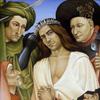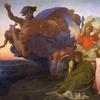Looking East: How Japan Inspired Monet, Van Gogh, and Other Western Artists
- SAN FRANCISCO, California
- /
- October 14, 2015
Japan’s opening to international trade in the 1850s after centuries of self-imposed isolation set off a craze for all things Japanese among European and North American collectors, artists and designers. The phenomenon, dubbed japonisme by French writers, radically altered the course of Western art in the modern era. San Francisco’s Asian Art Museum delves into this sweeping development in the traveling exhibition Looking East: How Japan Inspired Monet, Van Gogh, and Other Western Artists. The exhibition traces the West’s growing fascination with Japan, the collecting of Japanese objects, and the exploration of Japanese subject matter and styles. Looking East will be on view from Oct. 30, 2015–Feb. 7, 2016 with the exhibition's final weeks marking the start of the museum's 50th anniversary year in 2016. The museum will offer special events and activities throughout 2016 to commemorate this important milestone.
Looking East features more than 170 artworks drawn from the acclaimed collection of the Museum of Fine Arts, Boston, with masterpieces by the great impressionist and post-impressionist painters Vincent van Gogh, Claude Monet, Mary Cassatt, Edgar Degas, and Paul Gauguin, among others. The art and culture of Japan inspired leading artists throughout Europe and the United States to create works of renewed vision and singular beauty. Profoundly affected by Japan’s art, Van Gogh went so far as to write in an 1888 letter, “My whole work is founded on the Japanese.”
The exhibition is organized into four themes, tracing the impact of Japanese approaches to Women, City Life, Nature and Landscape. Within each theme, artworks from Japan are paired with American or European works to represent the West’s assimilation of new thematic and formal approaches. Japanese woodblock prints by such celebrated masters as Kitagawa Utamaro, Utagawa Hiroshige and Katsushika Hokusai are shown in dialogue with oil paintings, prints and photographs by a diverse mix of Western artists, demonstrating regional variations on japonisme. Bronze sword guards and paper stencils from Japan are juxtaposed with metalwork by Western manufacturers Boucheron, Gorham and Tiffany. Other objects used in daily life, like a chair designed by Frank Lloyd Wright, also show the wide-ranging impact of Japanese design in the West.
Additional highlights in the exhibition include Vincent van Gogh’s painting Postman Joseph Roulin; Claude Monet’s The water lily pond; Five Swans, an elegant wool tapestry designed by Otto Eckmann; Paul Gauguin’s canvas Landscape with Two Breton Women; and Kubo Shunman’s hanging scroll Courtesan in the Snow at the New Year.
Organized by the Museum of Fine Arts, Boston, the exhibition premiered at Nashville’s Frist Center for the Visual Arts, followed by a tour in Japan and then a stop at the Musée national des beaux-arts du Québec. The Asian Art Museum’s presentation, curated by Dr. Laura Allen, curator of Japanese art, and Dr. Yuki Morishima, assistant curator of Japanese art, is the final stop on the exhibition’s international tour.









100x100_c.jpg)




